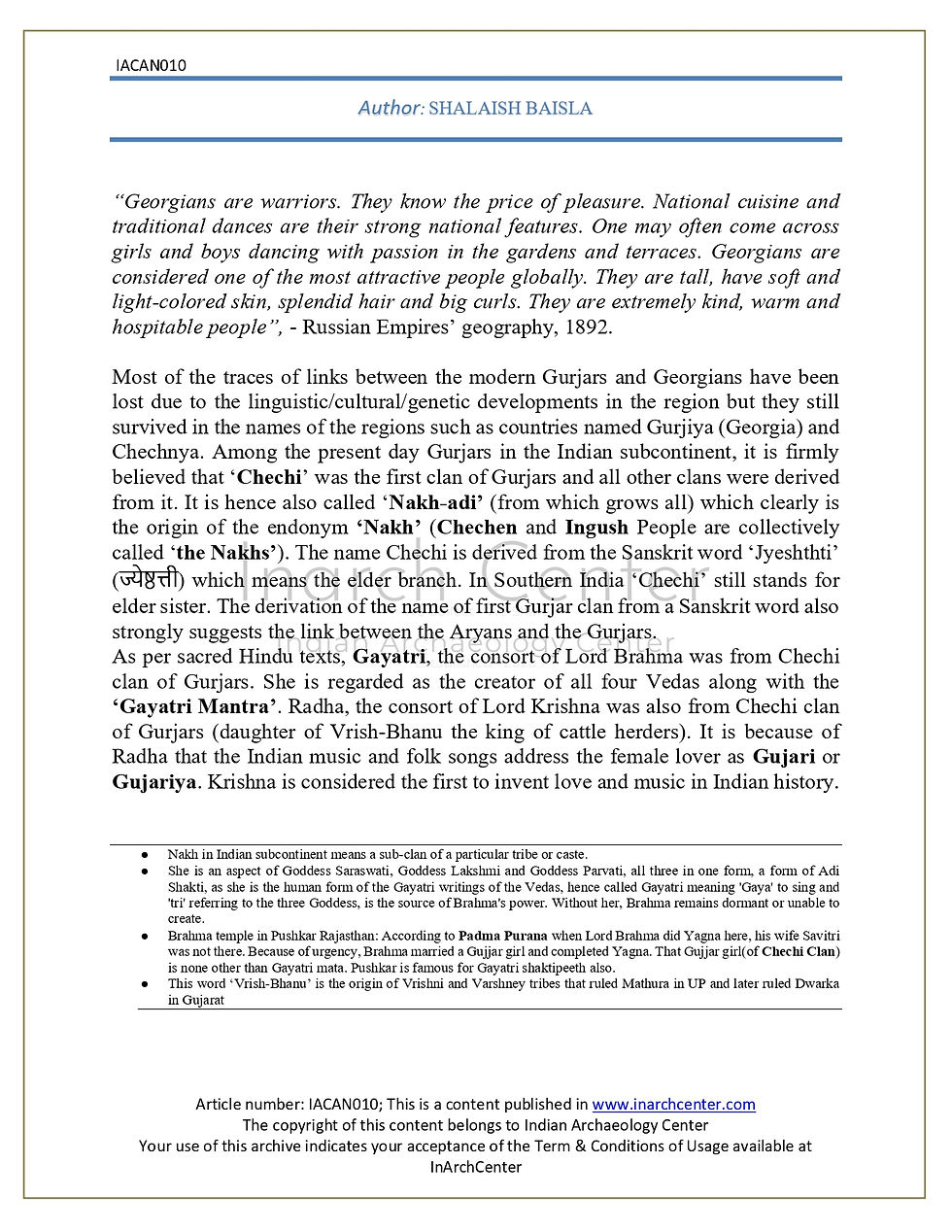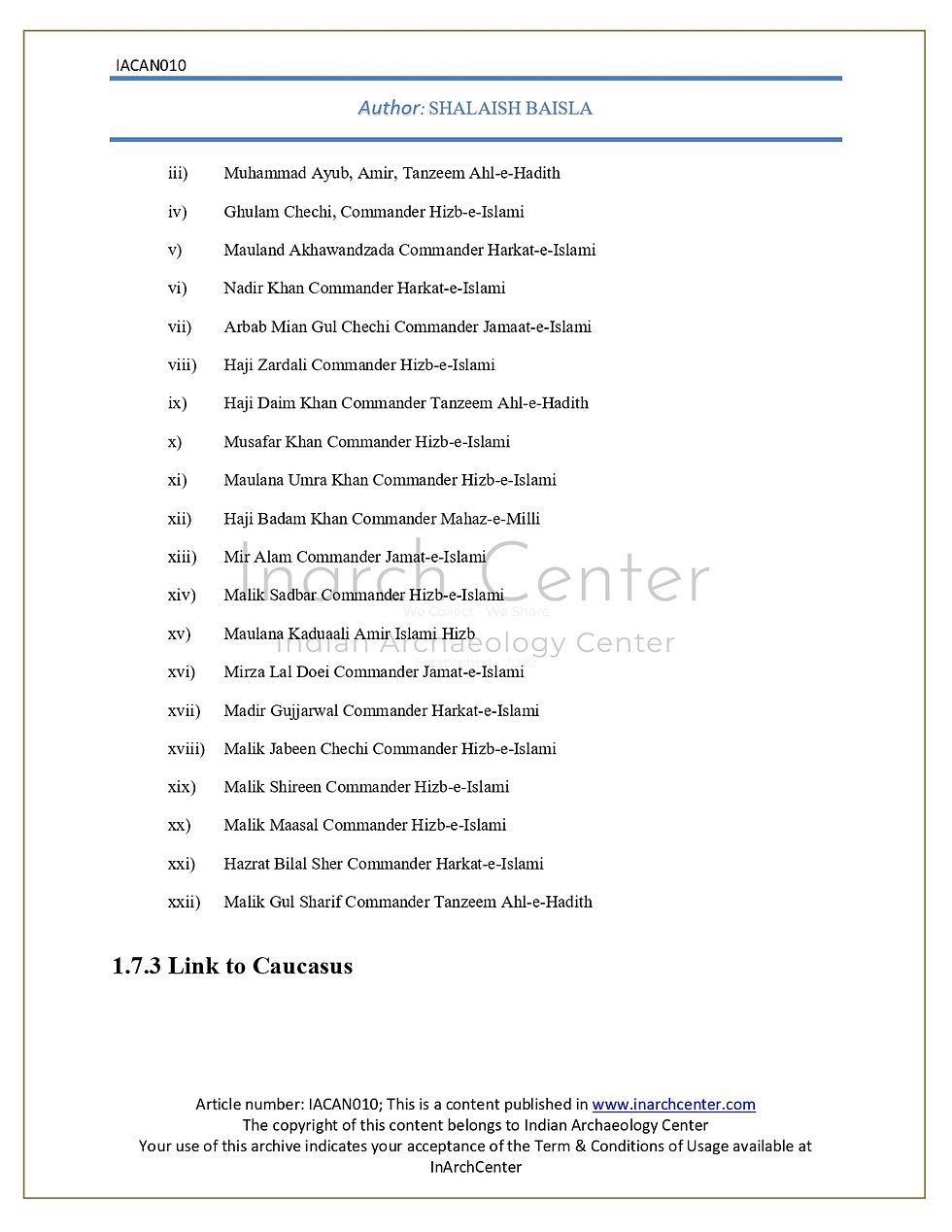ORIGIN AND CONTINUITY OF THE GUJJAR COMMUNITY AS SEEN THROUGH VARIOUS SOURCES
- Inarch Center
- Jan 26, 2022
- 6 min read
ABSTRACT
This Research is based on a long and extensive research on Gurjars (alternatively called Gujars, Gojars and Gujjars). The basic theory is a well-known fact that Aryans were the original inhabitants of the central Asian region (Caucasus). Although there are opposing theories but they don’t hold any ground as the ‘theory of Aryan migration’ theory has ecological, archaeological, linguistic and genetic evidences. These Aryans were Nomadic cattle herders as per the Vedic records. Their homeland, the region around Caspian Sea is very important in view of the world history. The Rigveda and the other sacred texts of the Hindu (and allied religions such as Buddhism, Jainism and Sikhism), together with the Zoroastrian and Abrahamanic scriptures, all mention this region as very important in one way or the other. There are striking similarities in the names, characteristics and legends of people originated in this area such as Manu & Nuh, Brahma & Abrahma, Caspian & Kasyapa, Danu & Danu-be, Sarai & Saraswati and Cacustha & Caucasus. These similarities, accompanied with historical, archaeological, genetic and linguistic evidences, cannot be written off as mere coincidences and imply a definite connection which proves that all major religions/civilizations eventually sprang from the Aryan religion, as also suggested by Isaac Newton. Aryans practiced Vedic religion but I don’t support they brought Vedas to India the knowledge was still there in India its misinterpretation by English Scholars . They ruled a large part of the world then known as Aryavrata. That included regions of modern-day Indian subcontinent, Eurasia, the Arabian Peninsula and Egypt at its zenith. This was the most fertile, most advanced, civilized and well habituated part of the then known world. However, Aryavrata later shrunk to the Indian subcontinent due to the internal conflict among the Aryan tribes. Most of the history of the Indian subcontinent was lost due to consistent invasions from west to capture this land. Only one rule was followed in Indian history: The victors were glorified and the losers were degraded. The ancient Aryan (Kshatriya) history was later ascribed to less deserving neo-Kshatriyas who were smart enough to connect their pedigree to ancient Aryans in a proficient manner but their attempts to replace the ancient Aryan tribes only further damaged the Aryan history and Vedic religion as the glorious period of the Aryans was then called the dark age of India. They had to evade the truth so that their sudden emergence would not be questioned by the later generations. Knowingly or unknowingly, they ruined the glorious history that they claimed to be their own.
The Aryans originated in Caucasus, settled in Anatolia & Levant and later expanded in all the directions in the world (called star like expansion) because of the mega flood in their homeland (Caucasus) as the result of the melting of glaciers at the end of the last glaciations period. They gave rise to various religions and kingdoms that covered most of the ancient world. Though there are billions of people with Aryan descent (most of the European, Iranian and Indian languages coming from the Indo-Aryan group) yet only a few were able to survive with their ancestral records and carry forward the legacy of the Aryans. Most of the modern people of Aryan descent have lost trace of their history due to mixture with local groups, absence of written records, natural calamities (draught, floods), epidemics and invasions by others etc. There were many people in the past, apart from the Indians, who identified themselves with the ancient Aryans, such as Hurrians, Alans, Goths, Germans, Persians, Slavs and Sarmatians etc. Their dominions were constantly in conflict with their neighbours. In absence of a common language and an eligible script they subsequently lost track of their glorious past. The Gurjars were one of those Aryan tribes that were lucky to have settled in the Indian subcontinent which did not have to face any large invasion until Alexander the Great set his eyes on it in 326 BC, but by then, Panini had composed Sanskrit as their common language which greatly helped in the survival of the Aryans’ chronological records and writing down their scriptures (that were, by then, only in oral form passing down from one generation to the other for thousands of years). The present day Gurjars, besides being semi-nomadic pastoralists, carry surprisingly similar physical attributes (nasal index, Skull/cephalic index, height and skin colour etc), rituals & traditions and warlike nature that the ancient Aryans were known for. Because of their strictly endogamous marriage practices they are genetically closer to the Aryans than any other Indian caste/tribe. In short, any Indian sub continental tribe that claims the Aryan descent has to first connect itself with these Gurjars as theirs’s is the only tribe to carry the long-lost legacy of the Aryans. They ruled large parts of the known world for more than 5000 years but in recent past, their history was mistakenly ascribed to other neo-Aryans (who claim descent from Fire, Sun and Moon). However, the rapid technological and scientific advances in genetic science have once again put the situation in the favour of Gurjars which is undoubtedly the only race that can safely claim the grand legacy of the Aryans. It seemed impossible to find the truth unless someone could go back in time and see for himself what actually happened but science actually made it possible with genetic testing methods. Now when we have reliable y-DNA testing available, most of the history can be revived and fake claims can easily be refuted.The first chapter discusses about the origin of gurjars in India and the world. References of various Ancient historians about gurjars, and origin as seen through various archaeological, linguistic and scientific sources and set the chronology. The second chapter traces the background of recorded the Hindu and Buddhists religious texts that Sumitra was the 124th king from the Ayudhya family who ruled as the last powerful Emperor of the Suryavanshi Aryans. He was defeated and probably killed by Maha Padma Nanda, the founder of the Nanda Dynasty in around 450 BC. The Nanda Empire lasted until 321 BC when Chandragupta the founder of the next dynasty killed the Last Nanda Emperor Dhana Nanda and established the Mauryan Empire in North India. The Suryavanshi kings were pushed towards the South Eastern Asia where they established new Empires such as Cambodia, Lob, Ayutha and Laos etc. There was another wave of migration from the North-West that re-introduced the Suryavanshi Aryans into the Indian subcontinent as Yaudheyas, Kushans, Huns and Pratihars etc. starting from the 1st Century BC. The third chapter discusses Huns/Hoons or Xions (Xyons) was an important tribe of Inner Asia that played a central role in the formation of various later kingdoms of the world such as the Khazars, Avars, Huns and Mongols. Their period is generally considered to be between the 3rd Century AD and the 6th Century AD. The latest studies have linked them with the Yuezhis who were displaced by the Kushans in the fight for supremacy over the Da-yuezhi confederation. The aftermath of this war for supremacy changed the history of the Indian subcontinent forever as the other four royal houses rose one after the other against their weakening overlords ‘Kushans’. These royal houses were all called ‘Hoons or Huns’ in the historical records. There were three major states known collectively as Xyon or Huns: The fourth chapter discusses A controversy has arisen over the word ‘Gurjara’. Does the word primarily denote the country, Gurjaradesa, Gurjarabhumi, Gurjaratra or Gujarat? And has the word been transferred to its rulers and residentsin its secondary meaning? Or was ‘Gurjara’ in its inception the name of an immigrating tribe or tribes and was later transferred to the tract where they first settled and to the kings and the people of that race? The fifth chapter discusses the first question, no doubt speculative, which arises in connection with the history of this period, is why did India go under the raids of Ghuri and Aibak between 1192 and 1210 B.C? Bhima of ratana, Prthviraja of Ajmere and Jayacandra of Kanauj each had a sufficient force to defeat the invader singly. Origin of Rajputs? Gujjars rich history, cultural heritage and their own language but constant conflict with the strong ruling dynasties such as Mughals and Britishers brought them to an oblivion state. In the subsequent chapters, the origins of Gurjar and their progressive evolution have been explained how Gurjars originally settled in the Caucasus and eventually settled in India, passing through Central Asia, Iran and Afghanistan. All the events of the growth of the Aryans and establishment of new empires and new religions throughout Indian continent have been explained.







































































































































For more detailed information on the same topic or if you want this file in pdf format, please check our Content on Demand page and write your demand there.
If you want to publish any blog or article feel free to contact us - Contact team InArchCenter
About Writer: -
Name: Shalaish Baisla
Education: PG Diploma - Deccan pune college; M.A.H.M - DIHRM, New Delhi
Location: Faridabad
Currently working on PRE-HISTORIC LOCALITIES OF ARAVALI, IN FARIDABAD
For more please contact our team


Comments